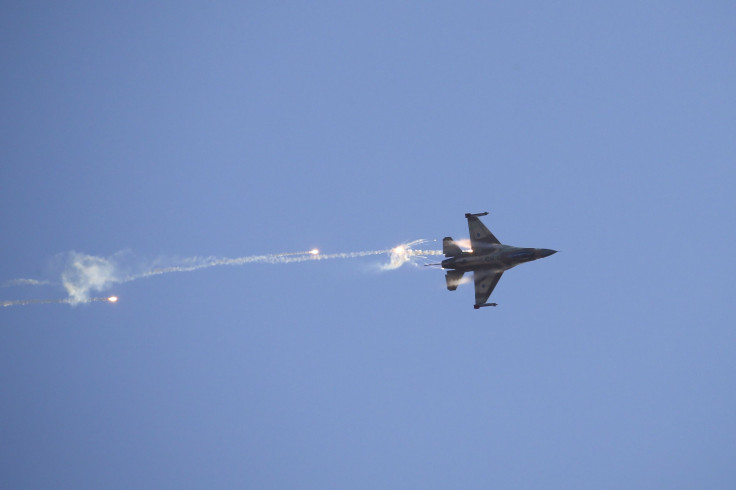Russia Strikes On Syria’s Southern Opposition Spark Fears of Cross-Border Conflict With Israel

BEIRUT — Russia’s involvement in Syria's war has concentrated on the northern and western regions of the embattled country, as part of a tacit understanding with Israel not to extend into its sphere of influence. But, as Syrian President Bashar Assad's forces push further south — with the help of Russian air cover and Iranian-backed militia — all bets are off. Israel has carried out several unacknowledged airstrikes inside Syria against the Iran-backed Lebanese armed group Hezbollah and Iranian forces, and some analysts say Israel looks closer to being drawn further into the conflict.
“If the Assad regime takes the entire Golan back, that could be Iran’s way to put in a second front and a second Gaza or a second southern Lebanon, to keep Israel busy,” Daniel Nisman, an Israeli security analyst with the Levantine Group, said in a recent interview with the Financial Times. Israel conquered the Golan Heights from Syria in the 1967 Six-Day War.
Iran, Israel, Russia and the U.S. all say their interventions in Syria are carried out with the intention of eliminating “terrorists.” But the definition and demographics of those labeled “terrorists” looks very different in Moscow than it does in Jerusalem. Russia supports the Syrian regime, Iran and the various Tehran-backed militias in Syria battling the Islamic State group (AKA ISIS), al Qaeda’s Jabhat al-Nusra and moderate Syrian rebels. Israel asserts that it wants to see al Qaeda and ISIS eradicated, but not at the cost of seeing Iran and Hezbollah set up shop on its northern borders with Syria and Lebanon. As the pro-regime southern operation intensifies, it could give Iran and Hezbollah a second front with Israel, the first being in Lebanon’s south:
“Syria has served as the main transit route by which Iran has armed and strengthened Hezbollah, making Damascus International Airport available for shipments of rockets and missiles that have been pivotal to Hezbollah’s challenge to Israel,” according to a report from the security and intelligence company Soufan Group.

Syria's combatants regard the conflict as a pan-Middle Eastern affair. A senior Hezbollah official in the south told International Business Times, “What’s going on in Syria is a regional war. The Iranians would not leave us alone in the battlefield with Israel.”
The fact that Syria is enabling Hezbollah and Iran to move their forces closer is not lost on the Israelis. Syrian rebel sources reported Sunday that Israel bombed a convoy of Iranian weapons headed for Hezbollah in Qalamoun, a mountainous region that borders Lebanon, near the contested border with Israel.
Tensions have been heating up on the Syrian border with Israel since the summer, when clashes in Syria’s Quneitra province were so close to the Golan Heights demarcation line that they set off missile-warning sirens in northern Israeli towns. The battles were a result of a push from rebels and Jabhat al-Nusra fighters against the predominantly pro-regime Druze town of Quneitra on the Syrian side of the de facto border.
The Israeli military did not respond to IBT’s request for a comment about the situation on its border with southern Syria.

Birthplace of the Revolution
Syria's southern front, in addition to sharing a border with two regional powers, Jordan and Israel, is the birthplace of the 2011 uprising against Assad that sparked the civil war. The area is also the last major stronghold for opposition forces backed and armed by the Military Operations Center, a command center that includes various Arab and Western allies, including the U.S.
In the recent push for Syria’s south, the Syrian army and its allies’ main focus has been on Sheikh Miskeen, a town strategically located on the second most important supply route in the southern provinces, which leads to the main city of Deraa and the Jordanian border that opposition forces seized in June.
#Syria #Daraa #JabhatAlNusra - Nusrats losing badly in #Sheikh_Miskeen pic.twitter.com/rECOKq9Ho9
— Doloroso (@Pynnha108) January 2, 2016The Syrian army’s first major push for the southern battlefield — Sheikh Miskeen in particular — began in October, with the help of intense Russian airstrikes in the area. This operation was focused on Tal Alharra , a town in the western outskirts of Deraa.
In late December, pro-Assad regime forces, including Hezbollah fighters, reached Sheikh Miskeen’s main square. Two weeks later, Hezbollah, Syrian army forces and Iran’s Revolutionary Guard Corps continued to engage in ground combat with opposition factions, including al Qaeda’s Jabhat al-Nusra, according to the Syrian Observatory for Human Rights.
Russian airstrikes supported the December operation and have continued to target the southern cities in support of pro-regime forces. The Institute for the Study of War reported several airstrikes in Deraa between Jan. 4 and 7. These strikes have not been confirmed by Russia, the report said, but Syrian activists and opposition media in the area say they continue.
The Observatory reported Sunday, “33 raids [were] carried out by warplanes since this morning on areas in the town of Sheikh Meskin.”
Rescue workers in the area told IBT on condition of anonymity that an Israeli reconnaissance plane was hovering in the area when Russian fighter jets hit in October.
“[Israel has] the ability to take some photos and have [its] targets so it's not difficult for [it to intervene in Syria],” the volunteer worker said. “The whole story is relevant to the Russian airstrikes.”
© Copyright IBTimes 2025. All rights reserved.






















